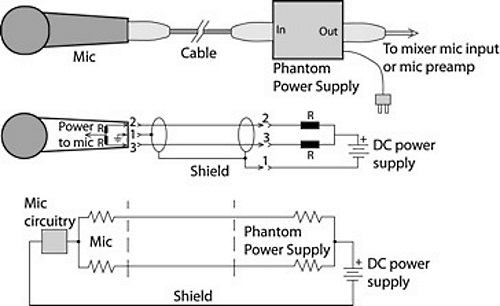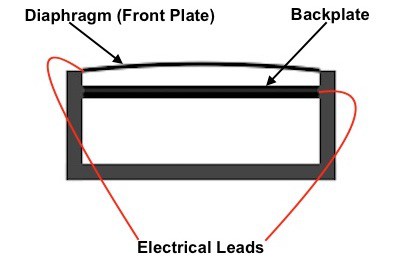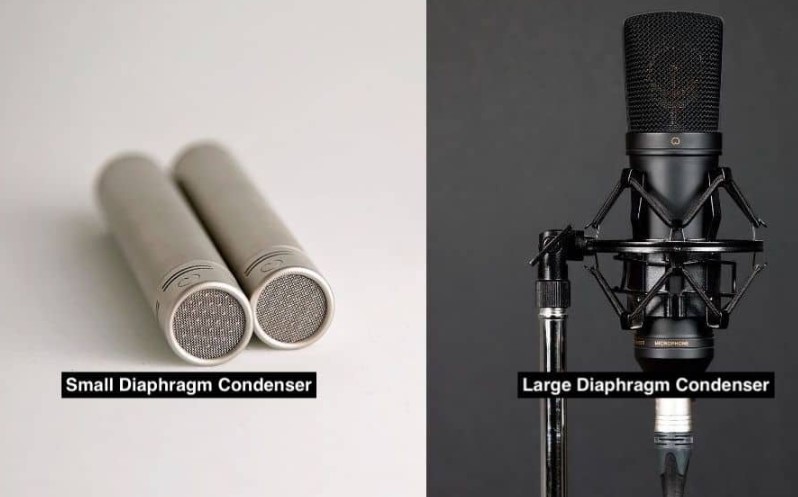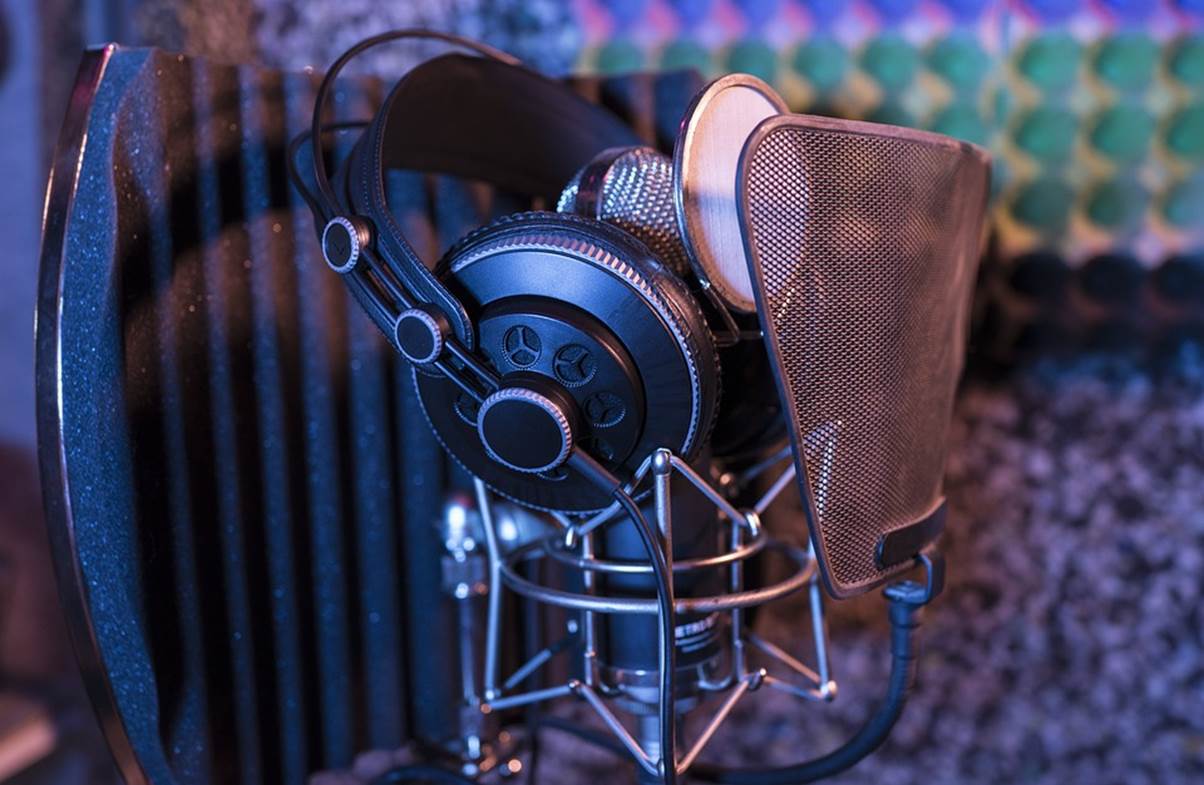Condenser microphones are the undisputed champions when it comes to capturing pristine audio quality. These exceptional devices have earned their place as a cornerstone in the toolkit of professionals and audio enthusiasts across various domains, including recording studios, podcast production setups, and live performances.

This comprehensive guide is your key to unlocking the captivating world of condenser microphones. Here, we will embark on a journey to uncover the intricate details of their construction, unravel the science behind their unparalleled functionality, delve into their diverse applications across industries, and understand precisely why they hold such an esteemed position in the realm of sound recording. Join us as we demystify these remarkable pieces of audio technology and equip you with the knowledge to harness their power for your audio endeavors.
Condenser Microphone At A Glance
A condenser microphone, often referred to as a capacitor microphone, represents a pinnacle of precision in the world of audio recording. This exceptional device serves as a transducer, a masterful converter that metamorphoses the subtleties of sound into electrical signals. To grasp the true essence of a condenser microphone, it’s essential to differentiate it from its dynamic counterpart, which operates on entirely distinct principles rooted in electromagnetic induction.

Understanding Condenser Microphone Construction
At the core of every condenser microphone lies a diaphragm, an ultra-thin membrane crafted from materials such as gold-sputtered mylar or metal-coated plastic. This diaphragm, suspended with a delicate balance, hovers in close proximity to a backplate, creating a minuscule yet pivotal gap between them. This gap, seemingly inconsequential in size, holds the key to the microphone’s extraordinary capabilities and gives birth to its namesake, the capacitor.
The Capacitor Conundrum
In a condenser microphone, sound waves interact with the diaphragm, causing it to vibrate in response to air pressure variations. This vibration initiates a sequence of events within the microphone. The interaction between the diaphragm and the nearby backplate, separated by a tiny gap, is where the magic occurs. This gap acts like a capacitor, experiencing subtle but significant changes in capacitance as the diaphragm sways with the incoming sound waves.

These capacitance alterations, akin to delicate whispers in the audio realm, are converted into an electrical voltage. This voltage faithfully mirrors the intricacies of the original sound and serves as the conduit for the microphone to communicate with recording equipment, amplifiers, and ultimately, the ears of listeners.
The Enigma of Phantom Power
A unique aspect of condenser microphones is their reliance on phantom power. This enigmatic term refers to a direct current (DC) electrical voltage, typically set at 48 volts, that is transmitted to the microphone via its connecting cable. Phantom power plays a pivotal role in the condenser microphone’s symphony by polarizing the diaphragm and backplate, priming them for the intricate dance of audio capture. This polarization is the secret sauce behind the microphone’s unparalleled sensitivity and precision.

Parts of a Condenser Microphone
A condenser microphone is a complex device composed of several key parts, each playing a crucial role in its functionality. Here are the main components of a condenser microphone:
- Diaphragm: The diaphragm is a thin, typically circular membrane made of materials like mylar or metal-coated plastic. It is the primary component that vibrates in response to sound waves, converting acoustic energy into mechanical movement.

- Backplate: The backplate is positioned close to the diaphragm and forms a capacitor with it. It is typically a fixed, stationary component that remains in place while the diaphragm vibrates.

- Capsule: The capsule is the assembly that contains both the diaphragm and the backplate. It is often sealed within the microphone body to protect these sensitive components from external elements.

- Phantom Power Supply: Condenser microphones require an external power source known as phantom power to polarize the diaphragm and backplate. Phantom power is typically provided through an XLR cable or interface and is usually set at 48 volts DC.

- Electronics and Circuitry: Inside the microphone’s body, there is a circuit that processes the electrical signal generated by the diaphragm’s movement. This circuitry may include an impedance converter, amplifier, and sometimes additional features like filters or pads.

- Output Connector: Condenser microphones typically feature an XLR output connector, which is a three-pin connection commonly used in professional audio equipment. Some modern condenser microphones may also have USB connectors for direct digital connection to computers.

- Grille and Housing: The grille is the protective mesh on the front of the microphone that shields the diaphragm and capsule from physical damage. The housing or body of the microphone encases all the internal components and provides structural support.

Differences Between Condenser and Dynamic Microphones
The primary difference between condenser microphones and dynamic microphones lies in their transducer principles:
Condenser Microphones: These microphones convert sound into audio signals using electrostatic principles. They are active transducers, requiring power for operation, although some ribbon mics are exceptions due to internal amplification circuitry. Condenser mics generally offer higher sensitivity and superior accuracy in both transient and frequency response.
Dynamic Microphones: Dynamic microphones, on the other hand, convert sound into audio via electromagnetic induction. They are passive transducers, except for some ribbon microphones with built-in amplification circuitry. Dynamic microphones are renowned for their durability and affordability compared to condenser microphones.
These fundamental differences in transducer principles lead to variations in sensitivity, accuracy, and pricing between condenser and dynamic microphones. These fundamental differences encompass various other distinctions, summarized below:
| Dynamic Microphones | Condenser Microphones | |
| Transducer Principle | Electromagnetic induction | Electrostatic principles |
| Active/Passive | Passive | Active |
| Frequency Response | Coloured | Flat/extended |
| Transient Response | Slow | Fast |
| Polar Patterns | All but bidirectional | All (especially with dual-diaphragm capsule) |
| Sensitivity | Low | High |
| Self-Noise | No | Yes |
| Maximum Sound Pressure Level | Often too high to measure | Often within practical limits |
| Durability | Very durable | Somewhat durable |
| Price | Inexpensive to moderate | Cheap to very expensive |
When Should I Choose Dynamic Over Condenser Microphones
While condenser microphones excel in various recording scenarios, specific situations favor the use of dynamic microphones. Consider dynamic mics when:
- Soundproofing is Lacking: In environments without adequate soundproofing or with substantial ambient noise, dynamic microphones are preferable. Their lower sensitivity minimizes the pickup of unwanted sounds, making them suitable for live performances and noisy settings.
- Handling and Mobility: If you anticipate frequent handling or movement during recording, dynamic mics are a practical choice. They are less susceptible to handling noise, though shock mounting can mitigate this issue, particularly with shotgun microphones.
- Durability Matters: Dynamic microphones tend to be more robust than condensers. In situations where microphones may undergo significant movement or rough handling, such as live performances, dynamics are often the better option.
While condenser microphones offer exceptional audio quality, dynamic microphones provide practical solutions in scenarios where sensitivity, handling noise, and durability are crucial considerations.
How Do Condenser Microphones Work?
At the heart of a condenser microphone lies a diaphragm, typically made of a thin conductive material like gold-sputtered mylar or metal-coated plastic. This diaphragm is suspended close to a backplate inside the microphone capsule, creating a small gap between them. This gap acts as a capacitor, hence the term “condenser” microphone.

When sound waves hit the diaphragm, it vibrates in response to the variations in air pressure. This causes the distance between the diaphragm and the backplate to change, altering the capacitance. These changes in capacitance correspond to the incoming audio signal and are converted into an electrical voltage.
Condenser microphones, like all mic types, serve as transducers, converting mechanical sound waves into electrical audio signals. They employ electrostatic principles in this process, which we’ll explore shortly later.
The Diaphragm
In a condenser microphone, the diaphragm is a thin, movable membrane linked to the microphone capsule’s edge. It reacts to differences in sound pressure between its front and back sides, mirroring the sound waves it encounters. This diaphragm is central to the microphone’s transducer function.

Parallel-Plate Capacitor
Condenser mic capsules function as parallel-plate capacitors. “Condenser” is an old term for a capacitor. The diaphragm functions as the movable front plate, while the stationary plate is called the backplate.

Electrostatic Principles
So, how does a moving diaphragm in a parallel-plate capacitor generate an audio signal? Let’s begin by exploring the first electrostatic principle:
V = Q * C
The voltage across a parallel-plate capacitor equals the product of the electrical charge between the plates and the capacitance.
- V: Voltage across the plates
- Q: Electrical charge between the plates
- C: Capacitance of the parallel-plate capacitor
Bear in mind that this equation is an idealized representation and real-world inefficiencies cause some losses in voltage, charge, and capacitance. Nevertheless, this equation holds true in theory.
Polarization and Impedance
To function correctly, condenser capsules (capacitors) must be charged. Specifically, they must maintain a stable charge. This is why all condenser mics are active, requiring power, and have very high impedance to prevent charge leakage.
This charge, also known as “polarization,” is supplied either externally through various power sources or internally using electret material strategically placed within the capsule. External-polarized condenser mics draw power from phantom power, external power supplies, T-power, batteries, or other sources. Electret mics are pre-polarized with quasi-permanent electret material.

With a constant charge, any change in capacitance causes a corresponding change in voltage across the plates. This leads us to the second electrostatic principle:
C = ε0(A/d)
The capacitance of a condenser capsule equals the product of the dielectric constant and the ratio of the plate area to the distance between the plates.
- C: Capacitance of the parallel-plate capacitor
- ε0: Dielectric constant
- A: Area of the plates
- d: Distance between the plates
This equation, too, is an idealized representation, with real-world inefficiencies affecting these factors. As the dielectric constant and plate area are constants, we can simplify the equation to state that the capsule’s capacitance is inversely proportional to the distance between the plates.
Generating the Audio Signal
Combining the above two electrostatic equations, we can conclude that the voltage across the capsule depends on the distance between the capsule plates. Therefore, when the diaphragm moves in response to sound waves, it causes an alternating current (AC) voltage across the plates.
As mentioned earlier, the diaphragm moves according to sound waves, essentially translating them into an AC voltage, which we refer to as an audio signal. In essence, the condenser mic capsule serves as a transducer.

Impedance Conversion and Signal Processing
However, the “signal” produced by the capsule has very high impedance, a result of maintaining a constant charge across the plates. To be usable within and beyond the microphone, it requires an impedance converter. Several methods, such as tubes and transistors, can be employed to reduce impedance, which we’ll discuss shortly.
Apart from this, condenser microphones may employ various circuits and output designs to further process the signal before it’s delivered as output.
Understanding the Condenser Mic Capsule
The condenser microphone capsule encompasses the entire transducer component of the microphone. It comprises the diaphragm, the backplate capacitor setup, and the protective housing that encases it.
Visualizing the Capsule
Take a glance at this simplified illustration representing the condenser mic capsule:

Condenser Mic Capsule
In the above diagram, you’ll notice the diaphragm and backplate, each with electrical leads extending from them. These leads carry the signal generated by the capsules to the impedance converter.
Electret Microphones and Acoustic Design
In electret microphones, electret material can be found either on the diaphragm, backplate, or even making up the diaphragm itself. Additionally, many capsules incorporate acoustic holes in the housing and backplate. These holes enable sound pressure variations behind the diaphragm, facilitating different polar patterns.
Examples of Condenser Microphone Capsules
Let’s delve into a selection of condenser microphone capsules, each offering unique characteristics and applications:
AKG CK12
The AKG CK12 stands as one of the most iconic and influential capsules in the world of microphones. It is a dual large-diaphragm multi-pattern capsule with a legacy dating back to 1953, where it first graced the design of the legendary AKG C12 microphone. Over the years, this design has been adopted in numerous other microphones, with the original AKG C12 setting an exceptionally high standard for audio quality.

Microphones equipped with the CK12 capsule often offer a range of selectable polar patterns and boast impressive frequency and transient response specifications. Notable examples include the AKG C 414 series and Telefunken’s Ela M line of microphones.
Neumann KK84
The Neumann KK84 represents a small-diaphragm cardioid condenser capsule, designed specifically for the top-address KM 184 microphone. Its unique design incorporates slits in the backplate to achieve cardioid directionality, offering exceptional audio clarity in challenging recording environments. The diaphragm is gold-sputtered polyester Mylar film, ensuring both durability and high-quality sound capture.

Rode HF6
The Rode HF6 represents a large-diaphragm cardioid condenser capsule, boasting a substantial 1-inch diaphragm diameter. Its design is edge-terminated, meaning that the conductive electrical leads are drawn from the edge of the housing rather than from the center of the diaphragm/backplate. This capsule is prominently featured in the renowned Rode NT1 microphone, known for its electret condenser technology and pre-polarized capsule.

Neumann K67
The Neumann K67 is a dual large-diaphragm multi-pattern condenser capsule, distinct for its center-terminated design. Originally introduced with the Neumann U 67 microphone in 1960, the K67 has played a significant role in shaping the world of audio recording. Unlike other capsules, the K67 features two diaphragms that share a single backplate, a design that allows for precise tuning and exceptional audio capture capabilities. It is renowned for its use in microphones that offer various polar patterns, making it a versatile choice for recording professionals.

These diverse capsule designs cater to a wide spectrum of recording requirements, ensuring that audio professionals have versatile tools at their disposal to capture sound with unparalleled precision and clarity.
Types of Condenser Microphones
Condenser microphones come in various types, each with unique characteristics tailored for different recording applications:
Large-diaphragm Condenser Microphones

Large-diaphragm condenser microphones, like the RØDE NT1-A, feature a larger membrane in their capsule, typically with a diaphragm of 1 inch (25.4mm) or greater. This design generates a higher signal voltage, reducing self-noise. They offer a lush and warm character, making them ideal for recording vocals and a range of instruments.
Small-diaphragm Condenser Microphones

Small-diaphragm condenser microphones, such as the RØDE NT5, provide a flatter and less colored signal compared to large-diaphragm counterparts. They excel in capturing natural sound, with extended low and high-frequency responses. These mics are well-suited for recording instruments like cymbals and acoustic guitars.
Tube Condenser Microphones

Tube condenser microphones, like the RØDE NTK, utilize vacuum tubes in their preamplifier circuit. They impart pleasant harmonics, saturation, and compression to sound sources, adding warmth and richness. However, they may have higher self-noise levels and require a separate power supply.
Shotgun Microphones

Shotgun microphones, exemplified by the RØDE NTG5, have a long, tubular design ideal for recording audio from a distance while maintaining focus and clarity. Their directional nature and phase cancellation technology filter out off-axis sounds, making them perfect for filmmaking and isolating sound sources.
USB Condenser Microphones

USB microphones, like the NT-USB Mini, offer a convenient solution for direct digital recording. They feature USB outputs and built-in Analog-to-Digital converters, eliminating the need for additional equipment like audio interfaces. USB mics are ideal for straightforward computer-based recording and often include headphone outputs for monitoring.
Each type of condenser microphone serves distinct purposes, providing recording professionals with versatile options to meet their specific audio needs.
Applications of Condenser Microphones
Condenser microphones are versatile tools suitable for various recording scenarios, thanks to their sensitivity and wide frequency range. Here’s a closer look at when and where you might choose to use a condenser microphone:
Podcasting and Broadcasting: USB condenser microphones provide a convenient solution for podcasters and broadcasters, offering plug-and-play functionality without the need for additional equipment.
Recording Drums: Often employed as overhead microphones for drum kits, condenser mics capture the cymbals and overall drum set ambiance. They can also be used for specific drum components like snare drums and toms.
Live Performances: Although less common than dynamic microphones in live sound, condenser mics find their place in live performances when detailed sound capture is desired, such as with choirs or orchestras.
Recording Acoustic Guitar: Condenser microphones, with their sensitivity, are ideal for recording acoustic instruments like guitars. They capture the natural resonance and overtones, preserving the instrument’s unique sound.
Field Recording: Small-diaphragm condenser microphones are popular choices for field recording, capturing ambient sounds, nature sounds, or on-location audio for film and video production.
Studio Production: In professional studio environments, large-diaphragm condenser microphones are favored for their ability to capture a wide frequency response and subtle sonic details, making them a top choice for producers and sound engineers.
Recording Vocals: Condenser microphones excel at capturing the nuances of the human voice, whether it’s lead vocals, backing vocals, or voiceovers, providing the clarity and detail required for exceptional vocal recordings.
Condenser microphones adapt seamlessly to diverse recording needs, making them invaluable tools in the world of audio recording and production.
Pros and Cons of Using Condenser Microphones
Pros
- Condenser microphones excel in delivering exceptional sound quality due to their wide frequency response, accurately reproducing both low and high frequencies.
- High sensitivity in quality condenser microphones allows them to pick up even the softest sounds, making them ideal for capturing intricate nuances, especially in vocal performances.
Cons
- Condenser microphones can be overly sensitive for live situations, potentially causing feedback issues in live sound settings.
- These microphones require phantom power, an external power source typically providing 48v DC current, which is necessary for their operation.
Small-Diaphragm vs. Large-Diaphragm Condenser Microphones
Condenser microphones vary based on the size of their diaphragms, which significantly impacts their performance and character. Here’s a general breakdown:

Small-Diaphragm Condenser (SDC)
Diaphragm diameter is less than or equal to 1/2″ (12.7 mm). SDCs are known for their precision and accuracy, making them ideal for capturing detailed sound, particularly in high-frequency ranges.
Large-Diaphragm Condenser (LDC)
Diaphragm diameter is greater than or equal to 1″ (25.4 mm). LDCs offer a warm and colored sonic character, often associated with a rich low end and a smooth high-frequency response.
While the classification is somewhat generalized, it provides a useful reference for understanding microphone characteristics. The table below summarizes the differences between SDCs and LDCs:
| Small-Diaphragm Condenser Microphones | Large-Diaphragm Condenser Microphones | |
| Diaphragm Size | 1/2″ (12.7 mm) or less | 1″ (25.4 mm) or more |
| Transient Response | More accurate | Less accurate |
| Frequency Response | Flatter and more extended | More coloured especially in the high-end |
| Address Type | Top or side | Typically side |
| Polar Patterns | Any polar pattern. Very consistent | Any polar pattern. Less consistent |
| Sensitivity | High | High |
| Self-Noise | More | Less |
| Price | Cheap to very expensive | Inexpensive to very expensive |
Conclusion
In conclusion, condenser microphones are incredible tools that have revolutionized the world of audio recording. Their ability to capture nuanced sound with exceptional clarity and detail makes them a staple in studios, live performances, and countless other applications. From recording vocals that convey the full spectrum of human emotion to capturing the intricate resonance of acoustic instruments, condenser microphones have earned their place as a go-to choice for professionals and enthusiasts alike.
Understanding the principles, types, and applications of condenser microphones empowers you to make informed decisions when selecting the right microphone for your specific needs. Whether you’re crafting the perfect vocal track, capturing the magic of live performances, or delving into the world of podcasting, condenser microphones are your trusted companions on your audio journey.
However, it’s important to recognize that no single microphone suits every purpose. While condenser microphones excel in many scenarios, there are situations where dynamic microphones shine due to their durability and suitability for high-noise environments.
Have you used condenser microphones in your recording endeavors? What are your favorite applications for them, and do you have any tips to share? We value your feedback and would appreciate hearing your thoughts on this article. Please take a moment to leave your comments and reviews below, helping us enhance our content to better serve your needs. Thank you for being a part of our community!
While condenser microphones offer excellent sensitivity and clarity for studio recordings, sometimes you need mobility without sacrificing audio quality. A wireless lavalier microphone provides convenience and flexibility in scenarios where movement or distance from the recording device matters.
Frequently Asked Questions
What are condenser microphones used for?
Condenser microphones are primarily used in studio environments where they excel in capturing clean, high-fidelity recordings with superior frequency and transient response, as well as lower self-noise. They are ideal for preserving the true sound source.
Are condenser microphones better?
In terms of recording quality, yes, condenser microphones are often considered better due to their higher sensitivity, wider frequency response, and greater dynamic range. They excel in studio recording, particularly for vocals and acoustic instruments.
Are condenser mics good for singing?
Yes, condenser microphones are excellent for singing, providing higher levels of detail and an accurate representation of the voice. They are particularly suited for live vocal performances, offering studio-quality sound on stage.
What are the benefits of condenser microphones?
Condenser microphones offer a wider dynamic range and higher frequency response compared to dynamic microphones. This results in realistic sound reproduction and a natural, warm tone.
What are the weaknesses of condenser microphones?
Key disadvantages include limitations in handling maximum signal levels, susceptibility to extreme temperature and humidity, and potential noise production in cheaper models due to electronic components.
Do condenser microphones need power?
Yes, condenser microphones require phantom power to operate. Phantom power is an electrical supply necessary for active electronic components within the microphone. Dynamic microphones, on the other hand, do not require phantom power.
Do condenser microphones have self-noise?
Condenser microphones typically exhibit low self-noise, with modern large diaphragm condenser mics having exceptionally low levels (around 11-15 dB-A). In most cases, this self-noise is virtually imperceptible within the context of a full mix.
How can I distinguish between dynamic and condenser microphones?
Dynamic microphones often feature cardioid or supercardioid polar patterns, while condenser microphones can have various patterns and may include a switch for changing polar patterns.
What is another name for condenser microphones?
Condenser microphones are also commonly referred to as “capacitor microphones” due to their construction, which involves forming a capacitor with a diaphragm.
What is the standout feature of a condenser microphone?
The sensitivity of condenser microphones is a standout feature. They can capture sound waves with remarkable accuracy and detail, making them perfect for recording sensitive sounds like acoustic instruments or vocal performances, even at low volumes.

































.png)






